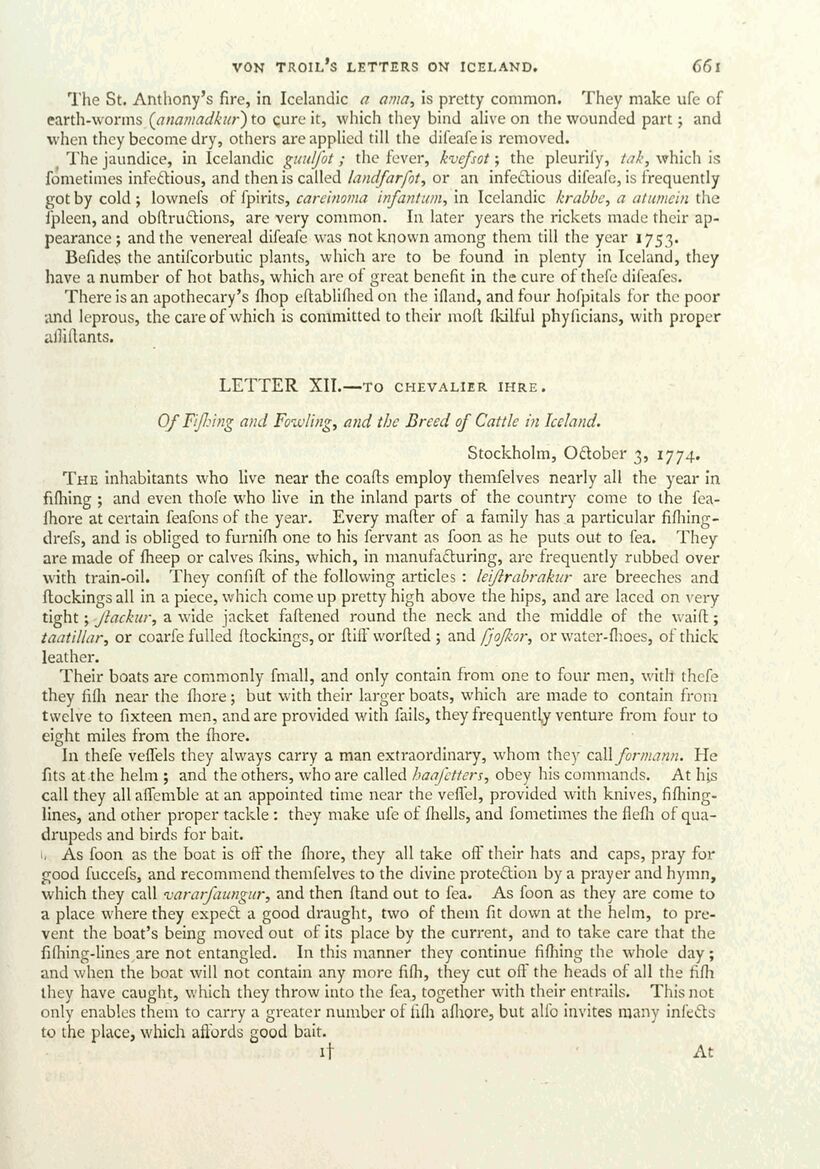
Full resolution (JPEG) - On this page / på denna sida - Pages ...

<< prev. page << föreg. sida << >> nästa sida >> next page >>
Below is the raw OCR text
from the above scanned image.
Do you see an error? Proofread the page now!
Här nedan syns maskintolkade texten från faksimilbilden ovan.
Ser du något fel? Korrekturläs sidan nu!
This page has never been proofread. / Denna sida har aldrig korrekturlästs.
VON TROIL’S LETTERS ON ICELAND, 661
The St. Anthony’s fire, in Icelandic @ ama, is pretty common. They make ule of
earth-worms (anamadkur) to cure it, which they bind alive on the wounded part ; and
when they become dry, others are applied till the difeafe is removed.
, The jaundice, in Icelandic gwuifot ; the fever, kvefsot; the pleurify, tk, which is
fometimes infectious, and thenis called /andfar/ot, or an infectious difeafe, is frequently
got by cold; lownefs of {pirits, careinoma infantum, in Icelandic krabbe, a atumein the
{pleen, and obftructions, are very common. {[n later years the rickets made their ap-
pearance ; andthe venereal difeafe was not known among them till the year 1753.
Befides the antifcorbutic plants, which are to be found in plenty in Iceland, they
have anumber of hot baths, which are of great benefit in the cure of thefe difeafes.
There is an apothecary’s fhop eftablifhed on the ifland, and four hofpitals for the poor
and leprous, the care of which is committed to their moft fkilful phyficians, with proper
afliftants.
LETTER XII.—tTo CHEVALIER IHRE.
Of Fifhing and Fowling, and the Breed of Cattle in Iceland.
Stockholm, October 3, 1774.
Tue inhabitants who live near the coafts employ themfelves nearly all the year in
fifhing ; and even thofe who live in the inland parts of the country come to the fea-
fhore at certain feafons of the year. Every mafter of a family has a particular fifhing-
drefs, and is obliged to furnith one to his fervant as foon as he puts out to fea. They
are made of fheep or calves fkins, which, in manufacturing, are frequently rubbed over
with train-oil. ‘They confift of the following articles : /ei/rabrakur are breeches and
ftockings all in a piece, which come up pretty high above the hips, and are laced on very
tight ; -/Zackur, a wide jacket faftened round the neck and the middle of the waift ;
taatillar, or coarfe fulled ftockings, or {tiff worfted ; and /yo/kor, or water-fhoes, of thick
leather.
Their boats are commonly fmall, and only contain from one to four men, witlt thefe
they fifth near the fhore; but with their larger boats, which are made to contain from
twelve to fixteen men, and are provided with fails, they frequently venture from four to
eight miles from the fhore.
In thefe veffels they always carry a man extraordinary, whom they call formann. He
fits atthe helm; and the others, who are called Aaa/etters, obey his commands. At his
call they allaffemble at an appointed time near the veflel, provided with knives, fifhing-
lines, and other proper tackle: they make ufe of fhells, and fometimes the flefh of qua-
drupeds and birds for bait.
As foon as the boat is off the fhore, they all take off their hats and caps, pray for
good fuccefs, and recommend themfelves to the divine protection by a prayer and hymn,
which they call vararfaungur, and then f{tand out to fea. As foon as they are come to
a place where they expect a good draught, two of them fit down at the helm, to pre-
vent the boat’s being moved out of its place by the current, and to take care that the
fifhing-lines are not entangled. In this manner they continue fifhing the whole day ;
and when the boat will not contain any more fifh, they cut off the heads of all the fifh
they have caught, which they throw into the fea, together with their entrails. This not
only enables them to carry a greater number of fifh afhore, but alfo invites many infects
to the place, which aflords good bait.
if | At
<< prev. page << föreg. sida << >> nästa sida >> next page >>